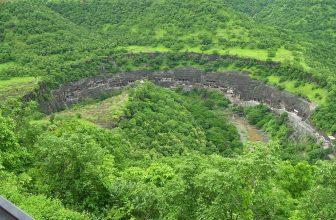Home » Sustainable Insights ( Blogs ) » Monday Flashback 18 – Sidi Saiyyed Mosque in Ahemdabad
Monday Flashback 18 – Sidi Saiyyed Mosque in Ahemdabad
This list of heritage places in Gujarat would look empty without the mention of the Sidi Saiyyed Mosque. The structure dates back to 1573. Interestingly, it was established by a slave of Sultan Ahmed Shah, Sidi Saiyyed, after whom the mosque is named as well.
This was among the last Sultanate structures in Gujarat. The interiors of the mosque are worth applause! Built in the Indo-Saracenic style of architecture, Sidi Saiyyed Mosque is adorned with intricate jaalis windows and chiseled marble.
Sidi Sayeed Mosque, Ahmedabad is a Marvelous piece of Architecture and is one of the Most Maintained & old Sustainable Buildings in the Country.
 In all, there are 10 windows with very intricate stone latticework. When the sun glows it looks like the orange glow of light, the intricate latticework of the windows is extraordinary as every shape is given by a thousand of stones to give the perfect shape & structure to the window, it created an effect so surreal and beautiful.
In all, there are 10 windows with very intricate stone latticework. When the sun glows it looks like the orange glow of light, the intricate latticework of the windows is extraordinary as every shape is given by a thousand of stones to give the perfect shape & structure to the window, it created an effect so surreal and beautiful.

 The Sidi Sayed Mosque is a small mosque that is still used for prayers by the devout Muslims of the area. It is bang in the center of the main traffic junction in the heart of Ahmedabad, the commercial capital of Gujarat, a western state of India. The famous Sidi Saiyyed Mosque in Ahmedabad is located in a small compound and is shaded by trees. Ten windows with intricate lattic work adorn the sides and the rear of the mosque. The most exquisitely carved window is known as the “Tree of Life”, and is a joy to behold, a resplendent ode to the artistic genius of its makers.
The Sidi Sayed Mosque is a small mosque that is still used for prayers by the devout Muslims of the area. It is bang in the center of the main traffic junction in the heart of Ahmedabad, the commercial capital of Gujarat, a western state of India. The famous Sidi Saiyyed Mosque in Ahmedabad is located in a small compound and is shaded by trees. Ten windows with intricate lattic work adorn the sides and the rear of the mosque. The most exquisitely carved window is known as the “Tree of Life”, and is a joy to behold, a resplendent ode to the artistic genius of its makers.
 Sidi Saiyad Jali history dates back to 1573. The construction of the Sidi Sayyed Mosque is attributed to an Abyssinian soldier by the name of Sidi Saiyyed in the year 1573, which coincidentally was also the last year of the Gujarat Sultanate with the Mughals led by Akbar taking over the kingdom.
Sidi Saiyad Jali history dates back to 1573. The construction of the Sidi Sayyed Mosque is attributed to an Abyssinian soldier by the name of Sidi Saiyyed in the year 1573, which coincidentally was also the last year of the Gujarat Sultanate with the Mughals led by Akbar taking over the kingdom.
 The mosque is apparently incomplete and some accounts attribute this fact to the Mughal invasion. The Sidi Saiyyed Ki Jali view at the entrance has two structures. It seems the two structures that frame the entrance to the courtyard of the Mosque were meant to be towers that were never completed. The central arch surprisingly does not have any latticework and is just covered with dull and drab stone. Probably another pointer to the incomplete nature of the structure. But whether complete or incomplete, the Sidi Sayyed Jali is a unique piece of architecture that has dazzled millions with its beauty across the passage of history.
The stone carving marvel in Sidi Saiyyed ni Jali is popular worldwide and has been executed in Indo-Saracenic style. The Founding fathers of the prestigious Indian Institute of Management, Ahmedabad were so impressed by the elegant and intricate design of The Tree of Life lattice window that they adopted it as their logo. The exquisitely crafted latticework is also in many ways a visual symbol of the city of Ahmedabad.
The mosque is apparently incomplete and some accounts attribute this fact to the Mughal invasion. The Sidi Saiyyed Ki Jali view at the entrance has two structures. It seems the two structures that frame the entrance to the courtyard of the Mosque were meant to be towers that were never completed. The central arch surprisingly does not have any latticework and is just covered with dull and drab stone. Probably another pointer to the incomplete nature of the structure. But whether complete or incomplete, the Sidi Sayyed Jali is a unique piece of architecture that has dazzled millions with its beauty across the passage of history.
The stone carving marvel in Sidi Saiyyed ni Jali is popular worldwide and has been executed in Indo-Saracenic style. The Founding fathers of the prestigious Indian Institute of Management, Ahmedabad were so impressed by the elegant and intricate design of The Tree of Life lattice window that they adopted it as their logo. The exquisitely crafted latticework is also in many ways a visual symbol of the city of Ahmedabad.
The mosque itself is quite spartan built in the style of architecture which most mosques in the country adhere to. The Sidi Saiyyed Mosque architecture is executed in an Indo-Saracenic style which combines elements of Indo-Islamic and Indian architecture. The famous Jali work of the screen in the Sidi Saiyyed Mosque is the source of attraction and the lodestone that drew people to its fold were the Jaalis ( also known as Sidi Saiyad Ni Jali ) or intricate lattice work of the windows of the mosque. The structure dates back to 1573. Interestingly, it was established by a slave of Sultan Ahmed Shah, Sidi Saiyyed, after whom the mosque is named as well.
 In all, there are 10 windows with very intricate stone latticework. When the sun glows it looks like the orange glow of light, the intricate latticework of the windows is extraordinary as every shape is given by a thousand of stones to give the perfect shape & structure to the window, it created an effect so surreal and beautiful.
In all, there are 10 windows with very intricate stone latticework. When the sun glows it looks like the orange glow of light, the intricate latticework of the windows is extraordinary as every shape is given by a thousand of stones to give the perfect shape & structure to the window, it created an effect so surreal and beautiful.

The rear wall is filled with square stone pierced panels in geometrical designs. The two bays flanking the central aisle have reticulated stone slabs carved in designs of intertwined trees and foliage and a palm motif. This intricately carved lattice stone window is the Sidi Saiyyed Jali, the unofficial symbol of city of Ahmedabad and the inspiration for the design of the logo of the Indian Institute of Management Ahmedabad.The central window arch of the mosque, where one would expect to see another intricate jali, is instead walled with stone. This is possible because the mosque was not completed according to plan before the Mughals invaded Gujarat
The mosque was used as a Government office during British rule. In 1880 CE paper casts of the carved screen were taken and two wooden models were made for the Museum of Kensington and New York.
 The Sidi Sayed Mosque is a small mosque that is still used for prayers by the devout Muslims of the area. It is bang in the center of the main traffic junction in the heart of Ahmedabad, the commercial capital of Gujarat, a western state of India. The famous Sidi Saiyyed Mosque in Ahmedabad is located in a small compound and is shaded by trees. Ten windows with intricate lattic work adorn the sides and the rear of the mosque. The most exquisitely carved window is known as the “Tree of Life”, and is a joy to behold, a resplendent ode to the artistic genius of its makers.
The Sidi Sayed Mosque is a small mosque that is still used for prayers by the devout Muslims of the area. It is bang in the center of the main traffic junction in the heart of Ahmedabad, the commercial capital of Gujarat, a western state of India. The famous Sidi Saiyyed Mosque in Ahmedabad is located in a small compound and is shaded by trees. Ten windows with intricate lattic work adorn the sides and the rear of the mosque. The most exquisitely carved window is known as the “Tree of Life”, and is a joy to behold, a resplendent ode to the artistic genius of its makers.
History Of The Sidi Sayyed Mosque
 Sidi Saiyad Jali history dates back to 1573. The construction of the Sidi Sayyed Mosque is attributed to an Abyssinian soldier by the name of Sidi Saiyyed in the year 1573, which coincidentally was also the last year of the Gujarat Sultanate with the Mughals led by Akbar taking over the kingdom.
Sidi Saiyad Jali history dates back to 1573. The construction of the Sidi Sayyed Mosque is attributed to an Abyssinian soldier by the name of Sidi Saiyyed in the year 1573, which coincidentally was also the last year of the Gujarat Sultanate with the Mughals led by Akbar taking over the kingdom.
 The mosque is apparently incomplete and some accounts attribute this fact to the Mughal invasion. The Sidi Saiyyed Ki Jali view at the entrance has two structures. It seems the two structures that frame the entrance to the courtyard of the Mosque were meant to be towers that were never completed. The central arch surprisingly does not have any latticework and is just covered with dull and drab stone. Probably another pointer to the incomplete nature of the structure. But whether complete or incomplete, the Sidi Sayyed Jali is a unique piece of architecture that has dazzled millions with its beauty across the passage of history.
The stone carving marvel in Sidi Saiyyed ni Jali is popular worldwide and has been executed in Indo-Saracenic style. The Founding fathers of the prestigious Indian Institute of Management, Ahmedabad were so impressed by the elegant and intricate design of The Tree of Life lattice window that they adopted it as their logo. The exquisitely crafted latticework is also in many ways a visual symbol of the city of Ahmedabad.
The mosque is apparently incomplete and some accounts attribute this fact to the Mughal invasion. The Sidi Saiyyed Ki Jali view at the entrance has two structures. It seems the two structures that frame the entrance to the courtyard of the Mosque were meant to be towers that were never completed. The central arch surprisingly does not have any latticework and is just covered with dull and drab stone. Probably another pointer to the incomplete nature of the structure. But whether complete or incomplete, the Sidi Sayyed Jali is a unique piece of architecture that has dazzled millions with its beauty across the passage of history.
The stone carving marvel in Sidi Saiyyed ni Jali is popular worldwide and has been executed in Indo-Saracenic style. The Founding fathers of the prestigious Indian Institute of Management, Ahmedabad were so impressed by the elegant and intricate design of The Tree of Life lattice window that they adopted it as their logo. The exquisitely crafted latticework is also in many ways a visual symbol of the city of Ahmedabad.
This Building is truely an Inspiration for True art lovers & a One of a kind Sustainable Building in India.
SaveSavedRemoved 0
Tags: Ahmedabad HeritageArchitectural Marvelsgreen BuildingGreen Building ExampleHeritage Sites in GujaratHistoric Mosque in AhmedabadIndian Institute of Management (IIM) AhmedabadIndo-Saracenic ArchitectureSidi Saiyad Jalisidi saiyyed mosqueSidi Saiyyed Mosque in Ahemdabadsidi saiyyed mosque in ahmedabadSustainable ArchitectureSustainable developmentSustainable Historic Buildings








